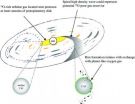(Press-News.org) Star-shaped cells in our brains called astrocytes were once considered little more than structures to fill the gaps between all-important neurons. But more recent evidence has emerged to reveal that those astrocytes play more than a supporting role; they are involved in information processing and signal transmission and they help to regulate the shapes of our neurons and their connections to one another.
Now, researchers reporting in the March 4th Cell, a Cell Press publication, have found that astrocytes are also essential for making long-term memories. When they don't function properly, rats develop amnesia.
More specifically, the new findings show that long-term memory formation depends on the delivery of lactate, an energy source derived from glycogen (a stored form of glucose), from astrocytes into neurons. If that transfer is blocked in any number of ways, rats fail to remember events that happened days or a week before. Their short-term memory, on the other hand, is unharmed.
"This is a novel way to think about how the brain works in making memories, and long-term memories in particular," said Cristina Alberini of Mount Sinai School of Medicine.
Scientists used to think it was all about changes to neuronal networks. "But that explanation simply isn't sufficient anymore," she said. "You need astrocytes and perhaps other cells as well; it's not just neurons."
There had been hints that astrocytes might have an important role to play in memory. Studies have shown that spatial learning and working memory in rats leads to an increase in the number of astrocytes. Learning in young chicks also depends on the breakdown of glycogen, a process known to occur in astrocytes and not in neurons.
Alberini teamed up some years ago with Pierre Magistretti of Ecole
Polytechnique Fédérale de Lausanne. His group had proposed that neurons and astrocytes might be linked through what they referred to as metabolic coupling, involving the transfer of lactate derived from glycogen from one cell type to the other.
Alberini's group had a perfect model for testing that idea in rats. Her team studies long-term memory and the underlying changes in the brain responsible by exposing rats to a single unpleasant experience – namely a footshock. After just one event, rats will form a lasting memory of the place where that footshock was delivered and avoid it. That avoidance behavior offers a way to measure the memory.
"When events are emotionally charged, we remember them much better," Alberini said.
Her group knows a lot about the changes that such a learning event produce in neurons of the hippocampus, a region of the brain that is central to learning and memory.
It's also clear that long-term memory and short-term memory are distinct, she explained. Short-term memory relies on modifications to proteins that are already present. Long-term memory depends on new protein synthesis and changes in gene expression that lead to a change in the structure of synapses, the connections from one neuron to another.
Now, Alberini and her colleagues report that in the rat hippocampus learning leads to a significant increase in extracellular lactate levels derived from glycogen stored in the astrocytes. That breakdown of lactate is essential for long-term but not short-term memory formation. In the absence of glycogen breakdown, rats initially remembered their negative experience, but by a day later they had forgotten. When rats were retested days later, their memory loss persisted.
Rats also developed amnesia when the lactate transporters on either their astrocytes or neurons were disrupted. When lactate was delivered straight to the brains of rats whose transport of lactate out of astrocytes was blocked, their ability to remember things in the long-term was restored. Interestingly, glucose, an alternative energy source, didn't work quite so well.
"Lactate must do something different or more efficiently," Alberini said. It's possible that lactate might be more than just an energy source, she says, an idea she plans to explore in further studies.
The findings not only shed light on how long-term memories are formed, but they may also have important implications for neurodegenerative diseases such as Alzheimer's and Parkinson's disease or the memory loss that simply comes with age.
"Those conditions often involve the loss of synaptic functions," Alberini said. "If this is a mechanism [for long-term memory formation] it opens up new avenues for investigation." Her team will look to animal models of degenerative diseases to see whether there is any evidence that the astrocyte-neuron lactate transport system may be disrupted.
###
END
Scientists have performed a micro-probe analysis of the core and outer layers of a pea-sized piece of a meteorite some 4.57 billion years old to reconstruct the history of its formation, providing the first evidence that dust particles like this one experienced wildly varying environments during the planet-forming years of our solar system.
The researchers interpret these findings as evidence that dust grains traveled over large distances as the swirling protoplanetary nebula condensed into planets. The single dust grain they studied appears to have formed in the hot ...
If you tend to have trouble picking up the latest dance moves or learning to play a new piano piece, there might be an explanation. A new study published online on March 3rd in Current Biology, a Cell Press publication, shows that people who are fast to learn a simple sequence of finger motions are also those whose brains show large changes in a particular chemical messenger following electrical stimulation.
That chemical messenger, known as GABA, is important for the plasticity of the motor cortex, a brain region involved in planning, control, and execution of voluntary ...
A new study finds that a brain rhythm considered the hallmark of wakefulness not only persists inconspicuously during sleep but also signifies an individual's vulnerability to disturbance by the outside world. In their report in the March 3 PLoS One, the team from the Massachusetts General Hospital (MGH) Division of Sleep Medicine uses computerized EEG signal processing to detect subtle fluctuations in the alpha rhythm during sleep and shows that greater alpha intensity is associated with increased sleep fragility. The findings could lead to more precise approaches to ...
There have been no shortages of horrific natural disasters splashing across headlines in the last year: the devastating earthquakes in Haiti and Chile; the Tsunami in the Philippines; and the volcano eruption in Indonesia--to name just a few. The poly tarps have come to the rescue over and over again in these situations, providing a cheap yet durable material with which to construct a roof or otherwise assist in the process of recovering and rebuilding from natural disaster born tragedy.
In the event of a natural disaster, as people are forced out of their homes or lose ...
How do organs "know" when to stop growing? The answer could be useful in regenerative medicine, and also in cancer – where these "stop growing" signals either aren't issued or aren't heeded. Researchers in the Stem Cell Program at Children's Hospital Boston have now found a regulator of gene activity that tells epidermal stem cells when it's time to grow more skin, as well as a "crowd control" molecule that can sense cell crowding and turn the growth off.
The work, in mice and in human cancer cells, provides clues to new therapeutic strategies for cancer, particularly ...
Not all racial and ethnic groups have equal access to kidney transplantation, according to a study appearing in an upcoming issue of the Journal of the American Society Nephrology (JASN). The results indicate that the reasons for these disparities are varied and that more focused efforts are needed to address them.
For most individuals who develop kidney failure or end-stage renal disease, kidney transplantation is the best treatment option. Unfortunately, certain racial and ethnic groups are less likely to receive kidney transplants than others. Despite the increasing ...
STANFORD, Calif. — Neurons have been derived from the skin of a woman with a genetic form of Parkinson's disease and have been shown to replicate some key features of the condition in a dish, say researchers at the Stanford University School of Medicine. The scientists hope to use the neurons to learn more about the disorder and to test possible treatments. Such a tool is critical because there are no good animal models for Parkinson's disease. It also validates the use of induced pluripotent stem cells, or iPS cells, to model various diseases.
"Now that we can see that ...
STANFORD, Calif. — A short-term treatment with three immune-dampening drugs allowed human embryonic stem cells to survive and thrive in mice, according to researchers at the Stanford University School of Medicine. Without such treatment, the animals' immune systems quickly hunt down and destroy the transplanted cells. The finding is important because it may allow humans to accept transplanted stem cells intended to treat disease or injury without requiring the ongoing use of powerful immunosuppressant medications.
Just as it does with transplanted organs, the human body ...
Plants are able to protect themselves from most bacteria, but some bacteria are able to breach their defences. In research to be published in Science on Friday, scientists have identified the genes used by some strains of the bacterium Pseudomonas to overwhelm defensive natural products produced by plants of the mustard family, or crucifers.
"Microbes only become pathogens when they find a way to infect a host and overwhelm the host defences," said lead author Dr Jun Fan from the John Innes Centre on the Norwich Research Park.
"Our findings answer some important questions ...
PULLMAN, Wash.—Scientific societies representing 40,000 researchers and clinicians are asking that federal regulators tap a broader range of expertise when evaluating the risks of chemicals to which Americans are being increasingly exposed.
Writing in a letter in the journal Science, eight societies from the fields of genetics, reproductive medicine, endocrinology, developmental biology and others note that some 12,000 new substances are being registered with the American Chemical Society daily. Few make it into the environment, but the top federal regulators, the U.S. ...


